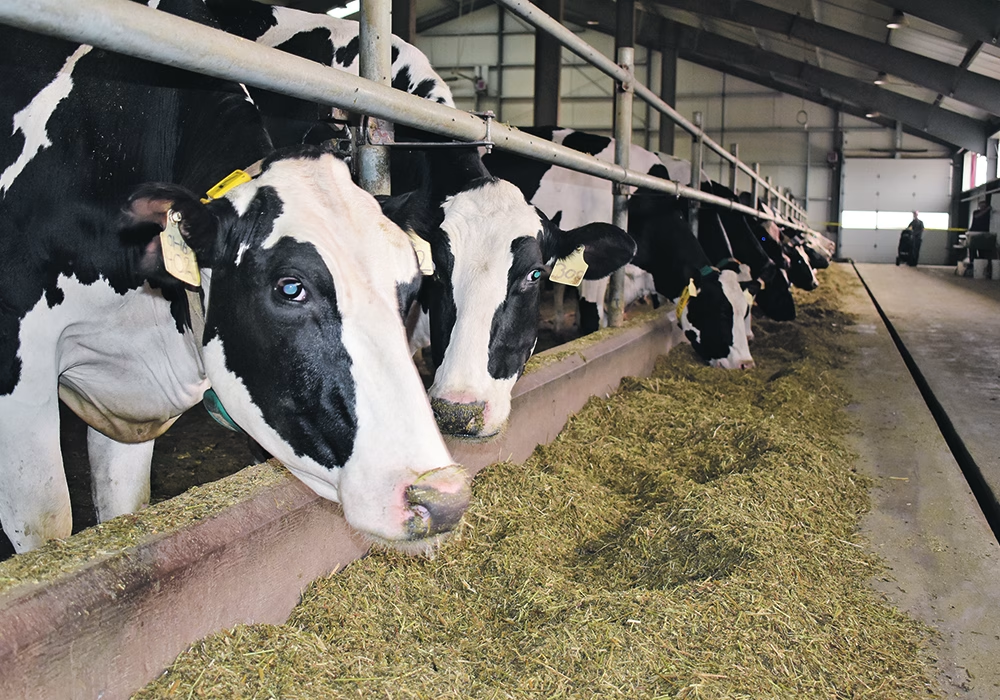Explore how cutting-edge genetic research offers US dairy farmers a powerful tool against Johne’s disease in Holsteins. Could integrating national genetic evaluations be the breakthrough for healthier herds?

Imagine a quiet but terrible illness destroying a part of your dairy herd. Through lower milk production, veterinary expenses, and early culling, Johne’s disease (JD) is an infectious intestinal illness generating major health problems and financial losses. JD is a slow-burning catastrophe in the dairy sector, and affects farm profitability and herd health. Understanding the genetic causes of US Holsteins is not just important, it’s crucial. These discoveries, made possible by genetic research, empower farmers to choose JD-resistant features, enhancing sustainability and herd health. The role of genetic research in combating JD is significant, giving farmers the tools they need to take control of their herd’s health. Including JD resistance into national genetic campaigns helps to lower the prevalence of the illness, therefore safeguarding agricultural economy and animal welfare. This fresh research, which emphasizes the role of genetic research in combating JD, shows important genetic tendencies and provides useful advice that may completely change dairy farming methods, therefore empowering fresh waves of industry innovation and development.
Combatting Johne’s Disease: Strategies and Genomic Innovations for Dairy Farmers
Mycobacterium avium subspecies paratuberculosis (MAP) causes the chronic bacterial illness known as Johne’s disease (JD) in dairy calves. It causes weight loss, ongoing diarrhea, lower milk output, and, finally, death. Although infection affects calves, dairy producers find it difficult because symptoms do not show until maturity.
JD affects the dairy sector with lower milk output, early culling, more veterinarian expenses, and even reputation loss. The illness may remain latent in herds for years because of a protracted incubation period during which infected cows disseminate MAP via feces, milk, and in-utero transmission.
Controlling JD typically involves:
- Improving farm hygiene.
- Managing calf-rearing practices.
- Testing and culling positive animals.
- Maintaining strict biosecurity.
These techniques have their limits. Intermittent MAP shedding means diagnostic tests often miss infections, and culling can be financially challenging, significantly if many cows are affected.
Consider a mid-sized dairy farm in Wisconsin with 500 Holstein cows and a 5% prevalence rate of Johne’s disease. This translates to about 25 cows needing culling, each representing a financial loss of $1,500 to $2,000. Thus, the farm could initially hit $37,500 to $50,000, not including reduced milk production or veterinary costs.
Frequent testing adds logistical hurdles and expenses. At $30 per sample, biannual testing of the entire herd could cost $30,000 annually. There’s also operational disruption from segregating infected animals, increased labor for handling and testing, and the need for continuous monitoring due to intermittent MAP shedding.
For larger herds or multiple farms, these economic and logistical burdens grow even more. While genetic selection and advanced management practices promise long-term control of Johne’s disease, successful implementation must carefully balance costs, herd health, and farm sustainability.
Management strategies alone cannot eliminate JD. Still, its economic influence and frequency need more robust answers. Over time, a nationwide genetic examination for JD susceptibility, selective breeding of resistant cattle, and current management strategies might considerably lower Johne’s disease in dairy herds. This method emphasizes the need for genetic assessments in enhancing herd health and sustainability and presents a possible answer to a current issue.
Digging Deep: How Genetic and Phenotypic Data Can Unveil Johne’s Disease Susceptibility in US Holsteins
Only one positive ELISA result from the first five parties was needed to classify a cow as JD-positive. This isn’t random; JD often appears in adult cows, so focusing on these early lactations captures the crucial infection period. This method ensures accuracy in detecting JD, laying a solid foundation for a reliable genetic evaluation.
The first five lactations align with peak milk production periods, improving the precision of genetic parameter estimates. Using multiple parities ensures a comprehensive dataset, reducing the chance of false negatives. This thorough approach highlights the study’s dedication to accurately assessing JD susceptibility.
This method guarantees correct identification of sick animals and offers consistent information for genetic analyses.
To study the genetic basis of JD susceptibility, three models were used:
- Pedigree-Only Threshold Model (THR): This model utilizes pedigree data to estimate variance and heritability, capturing familial relationships’ contributions to JD susceptibility.
- Single-Step Threshold Model (ssTHR): This model combines genotypic and phenotypic data, offering a precise estimate of genetic parameters by merging pedigree data with SNP markers.
- Single-Step Linear Model (ssLR): This model uses a linear framework to combine genotypic and phenotypic data, providing an alternative perspective on heritability and genetic variance.
Unlocking Genetic Insights: Key Findings on Johne’s Disease Susceptibility in US Holsteins
The research results provide critical new perspectives on Johne’s disease (JD) sensitivity in US Holsteins, stressing hereditary factors and dependability measures that would help dairy producers address JD. Using threshold models, heritability estimates fell between 0.11 and 0.16; using a linear model, they fell between 0.05 and 0.09. This indicates some hereditary effects; however, environmental elements are also essential.
The reliability of estimated breeding values (EBVs) for JD susceptibility varied somewhat depending on techniques and models. The reliability of the IDEXX Paratuberculosis Screening Ab Test (IDX) ran from 0.18 to 0.22, and that of the Parachek 2 (PCK) protocol ran from 0.14 to 0.18. Though small, these principles are an essential initial step toward creating genetic assessments for JD resistance.
Even without direct genetic selection against JD sensitivity, the analysis revealed significant unfavorable genetic tendencies in this trait. Targeted breeding techniques allow one to maximize this inherent resilience. Including JD susceptibility in genetic assessments could help dairy producers lower JD incidence, lower economic losses, and enhance herd health.
The Game-Changer: Integrating Genetic Insights into Dairy Farming Practices
Using these genetic discoveries in dairy farming seems to have a transforming power. Including Johne’s disease (JD) susceptibility into national genetic screening systems helps dairy producers make more educated breeding choices. Choosing cattle less prone to JD will progressively lessen its prevalence in herds, producing better cows and reducing economic losses.
Moreover, a nationwide genetic assessment system with JD susceptibility measures would provide consistent information to support thorough herd management plans. Farmers may improve herd resilience by concentrating on genetic features that support disease resistance, lowering JD frequency and related costs such as veterinary fees and lower milk output.
In the long term, these genetic developments will produce a better national Holstein population. The dairy business will become more efficient and profitable as more farmers embrace genetic assessment programs, which help lower the overall incidence of JD. Better animal welfare resulting from healthier cattle will increasingly influence consumer decisions and laws.
These genetic discoveries provide a road forward for raising national dairy farming’s health and production standards and individual herd development. Including JD susceptibility into breeding techniques helps farmers safeguard their assets and guarantee a more lucrative and environmentally friendly future.
The Bottom Line
The analysis of Johne’s disease (JD) in US Holsteins emphasizes the use of genetic data to enhance herd health. By means of extensive datasets, insightful analysis, and stressing the relevance of this study in dairy farming, researchers have revealed vital new insights on JD susceptibility, which are, therefore, guiding breeding plans.
Recent research can benefit dairy farmers aiming to tackle Johne’s Disease (JD) in their herds. Using genetic insights and modern testing protocols, farmers can take steps to reduce this costly disease.
Critical Steps for Dairy Farmers:
- Regular Testing: Kits like the IDEXX Paratuberculosis Screening Ab Test (IDX) and Parachek 2 (PCK) screen milk samples from the first five parties.
- Genetic Analysis: To gauge JD susceptibility, utilize SNP markers and models like pedigree-only threshold models or single-step models.
- Selective Breeding: Incorporate JD susceptibility evaluation into your breeding programs to gradually reduce disease incidence.
- Monitor Trends: Keep an eye on genetic trends in your herd and adjust breeding strategies accordingly.
- Collaborate with Experts: Consult with geneticists and vets to understand JD’s genetic correlations with other important traits.
By adopting these strategies, dairy farmers can reduce the impact of Johne’s Disease, improving herd health and economic efficiency.
Including JD susceptibility in breeding campaigns helps produce healthier and more productive herds, lowering economic losses. Dairy producers should take these genetic elements into account when designing their breeding plans to fight JD properly.
Integration of JD susceptibility into national genetic assessments is next, and it is absolutely vital. This will simplify the choice process for JD resistance, therefore strengthening the dairy sector’s general resilience.
As a dairy farmer focused on herd health and productivity, including JD susceptibility in your breeding plans is crucial. Use these genetic insights to create a resilient dairy operation. Make informed breeding choices today for a stronger future.
Key Takeaways:
- Johne’s disease (JD) is a significant economic concern in the dairy industry, affecting ruminants globally.
- Recent data show a 4.72% incidence rate of JD in US Holstein cattle.
- Genetic and phenotypic data were analyzed using three models: THR, ssTHR, and ssLR.
- Heritability estimates of JD susceptibility ranged from 0.05 to 0.16, indicating low to moderate genetic influence.
- Reliability of genetic evaluations varied across models, with ssLR showing slightly higher reliability.
- Despite no direct genetic selection, trends indicated a significant reduction in JD susceptibility over time.
- Genetic correlations between JD susceptibility and other economically important traits were low, suggesting independent selection pathways.
- Incorporating JD susceptibility into national genetic evaluations could help reduce incidence rates.
Summary:
Johne’s disease (JD) is a chronic bacterial illness affecting dairy cattle, causing weight loss, diarrhea, lower milk output, and death. It affects farm profitability and herd health, and genetic research is crucial for farmers to choose JD-resistant features. Controlling JD involves improving farm hygiene, managing calf-rearing practices, testing and culling positive animals, and maintaining strict biosecurity. However, these techniques have limitations, such as intermittent MAP shedding, which can lead to missed infections and financial challenges. A nationwide genetic examination, selective breeding of resistant cattle, and current management strategies could significantly lower JD in dairy herds. Integrating genetic insights into dairy farming practices could help producers make educated breeding choices, reduce JD prevalence, produce better cows, and reduce economic losses. In the long term, these genetic developments will lead to a better national Holstein population, making the dairy business more efficient and profitable.












